My delightful Puran Poli recipe with step-by-step photos will show you how to make the traditional Indian treat. This lentil stuffed sweet flatbread is a popular Maharashtrian recipe made during Ganesh Chaturthi, Diwali, Holi or any other festive occasion. While it does take a bit of skill and patience to make, the results are well worth it! And as an added bonus, this sweet recipe also happens to be pretty darn nutritious, meaning you can even eat it for breakfast.
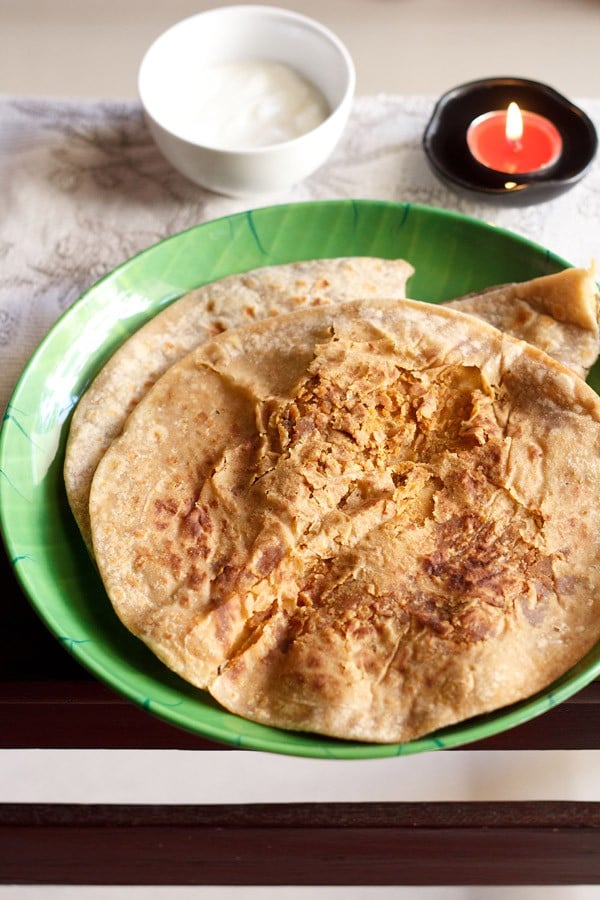
About Puran Poli
Puran Poli is a flatbread stuffed with a sweet lentil stuffing. In Marathi language the sweet stuffing is known as Puran, and the flat bread is called Poli. While puran poli is considered a sweet, the ingredients make it quite healthy.
There are a few variations of this delish flatbread found in the Western and Southern parts and regions in India.
A similar variation in South India and from the Andhra and Karnataka cuisine is called Bobbatlu or Obbattu or Holige, where the proportions of flours may vary together with the kind of flavoring spices and lentils used.
In the authentic Maharashtrian Puran Poli recipe, the stuffing is made from chana dal (also known as bengal gram) which are husked and split black chickpeas.
The cooked chana dal lentils are sweetened with jaggery and spiced with cardamoms, fennel, nutmeg and ginger. The chickpeas are full of protein, fiber, folate and vitamins.
The poli (flatbread) is made from a mix of whole wheat flour (atta) and all purpose flour (maida). Whole wheat flour is also chock full of fiber, protein and minerals.
If you prefer a yellow colored flatbread, you can add some ground turmeric powder in the dough, which would add some anti-inflammatory power to these treats.
So if you are someone who has a naughty sweet tooth but are trying to be nice to your body, try making this delicious dessert that you truly can feel good about.
Making Puran Poli recipe is easy, but it takes time. Be sure to plan in advance before making it. Feel free to prepare the sweet stuffing a day or two before and refrigerate it.
This way you can break up the process into more easily achievable bites. The following day, make the dough, shape the poli and pan fry them. Easy peasy!
About Jaggery
Jaggery is an unrefined sugar that is easily available in India. If you live outside India, then check for jaggery in asian or Indian grocery stores or on Amazon.
Jaggery has a lower glycemic index than sugar, and also contains vitamins and minerals that are beneficial to health.
Note: If you are unable to procure jaggery, check for Mexican piloncillo, Latin American panela or muscovado sugar, all of which are similar.
How to make Puran Poli
Cook Chana Dal
1. Rinse 1 cup of chana dal very well in water. I didn’t soak the chana dal, but you can soak the chana dal for 30 minutes to one hour and then drain the water.
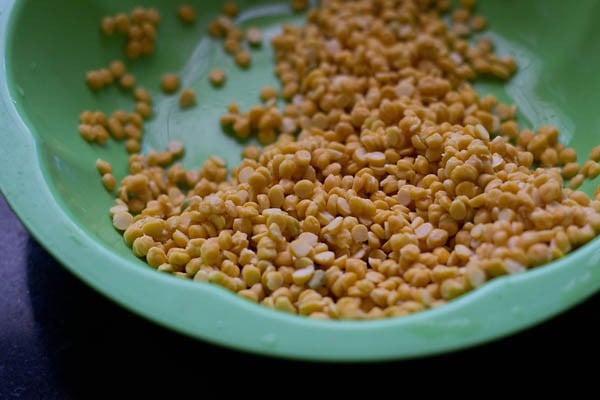
2. In a 3 litre stovetop pressure cooker, cook the chana dal with 3 cups of water for 6 to 7 whistles on medium heat. The dal need should not be mushy or pasty but cooked tender and softened.
Allow the pressure to release naturally in the cooker, then strain the cooked dal. Keep the dal in the strainer for several minutes so that all the stock is drained. The cooked lentils have to be drained very well.
Tip: Keep the lentil stock aside. It can be used for making Katachi Amti (thin spiced dal) or you can just add it to your veggie dishes or roti dough.
Note that you can also cook the lentils in an Instant Pot or in a pan/pot on the stovetop. If cooking lentils in a pot on the stovetop, make sure to soak them for an hour or two.
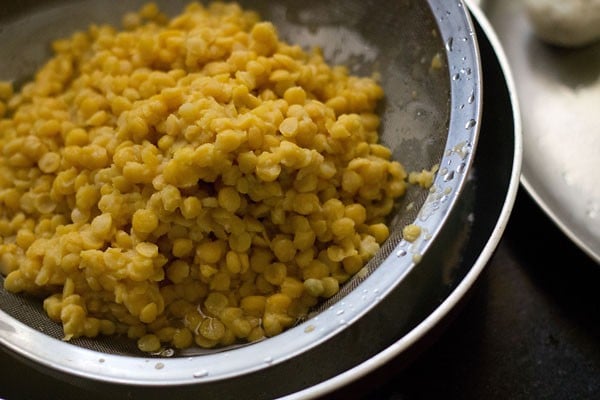
Make Puran (Lentil Filling)
3. Lightly heat 2 teaspoons ghee in a pan (keeping heat to a low) and add the following ground spices:
- ¾ to 1 teaspoon dry ginger powder (ground ginger)
- ¼ teaspoon nutmeg powder
- ½ teaspoon green cardamom powder
- 1 teaspoon fennel powder
Fry for a few seconds on low heat; this will help the natural oils in the spices to awaken and taste more flavorful.
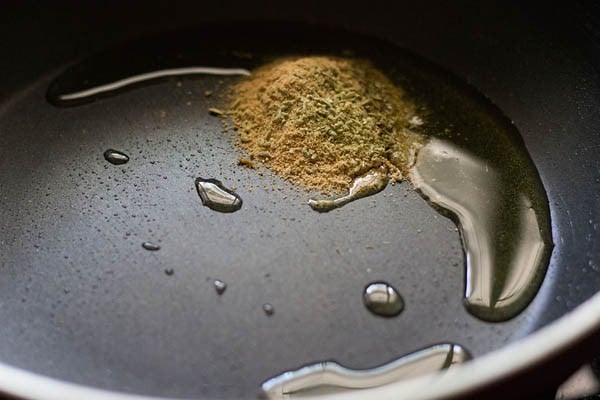
4. Add the cooked chana dal and 1 cup of powdered or grated jaggery. Stir and let the puran mixture cook on a low heat till the mixture becomes dry, stirring at intervals.
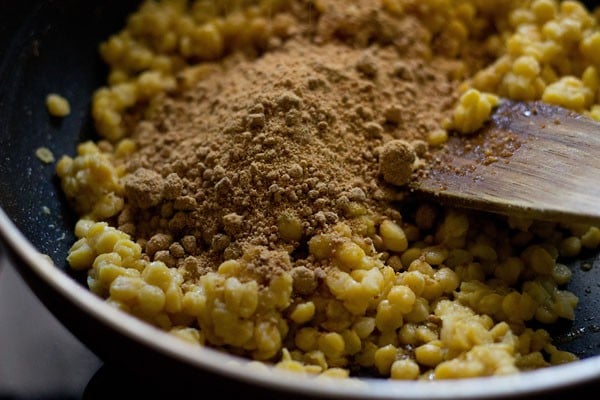
8. The puran mixture has cooked now and the below photo shows the thick, dry consistency you should have. Let this stuffing mixture cool.
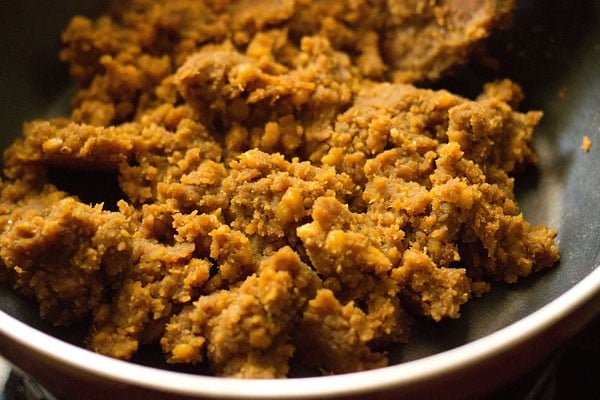
9. Now mash the puran mixture very well with a potato masher or strainer. You need to mash the lentils thoroughly as the whole pieces of lentils may cause the dough to crack or tear while rolling.
Note: There is a piece of equipment called ‘puran yantra’ which is used in Maharashtrian households to do this work, but I do not have this equipment. In America, the puran yantra would be considered very similar to a food mill.
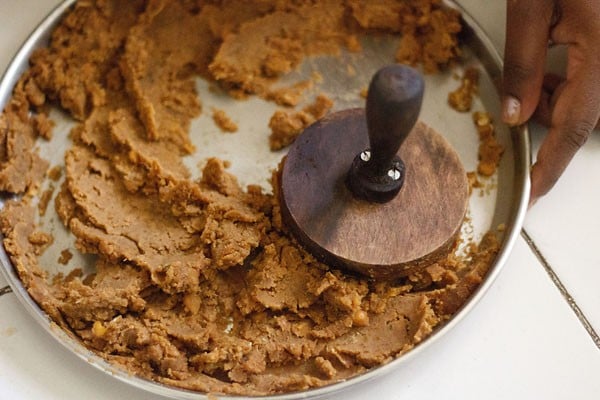
Make Poli (Flatbread) Dough
5. Meanwhile while the sweet lentil filling is cooling, prepare your dough to make the outer cover or poli.
Take 1.5 cups whole wheat flour, 1 cup all-purpose flour and ½ teaspoon salt in a bowl. Mix well.
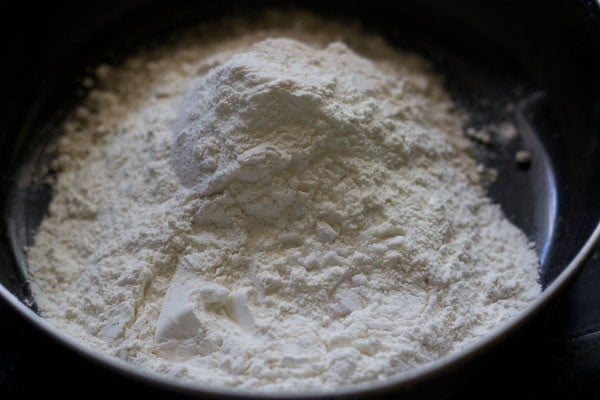
6. Add a little bit of water and 4 tablespoon ghee or oil and mix.
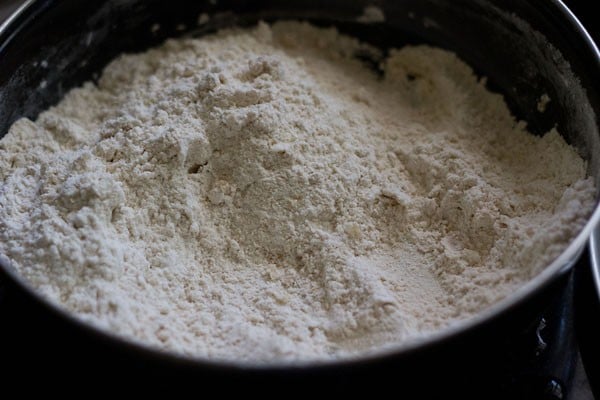
7. Begin to knead the dough, adding water as required. The dough should be smooth, supple and soft. Cover and rest the dough for 15 to 20 minutes.
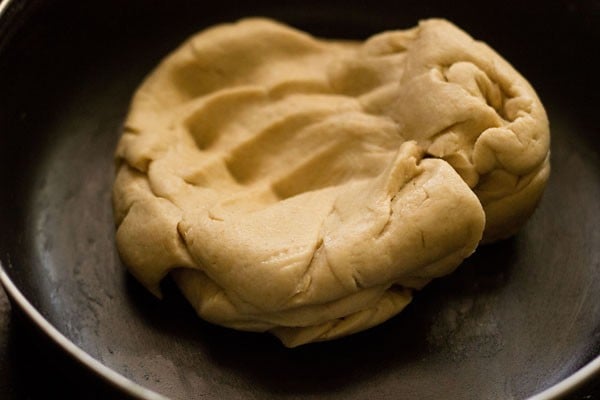
Assemble and Roll
10: Take a medium or large size ball from the dough. With a rolling pin, roll it 2 to 3 inches in circumference on a dusted rolling board. Place a portion of puran mixture in the center of the rolled dough.
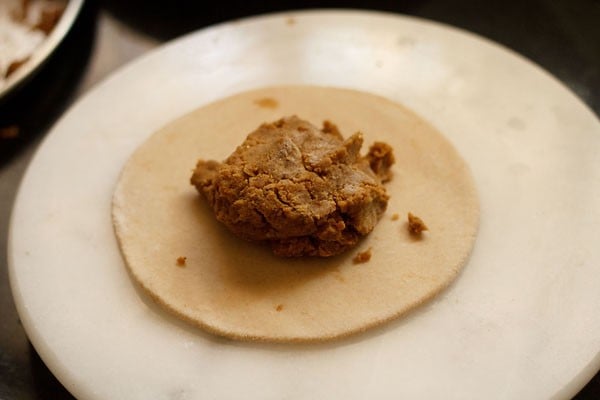
11. Bring the edges together towards the center as shown in the below pic.
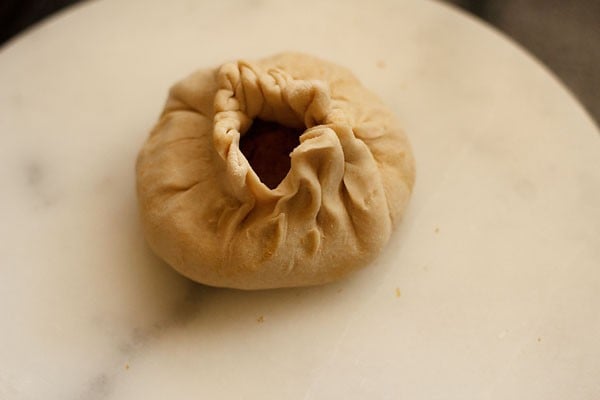
12. Join all the edges and pinch them as shown in the picture below.
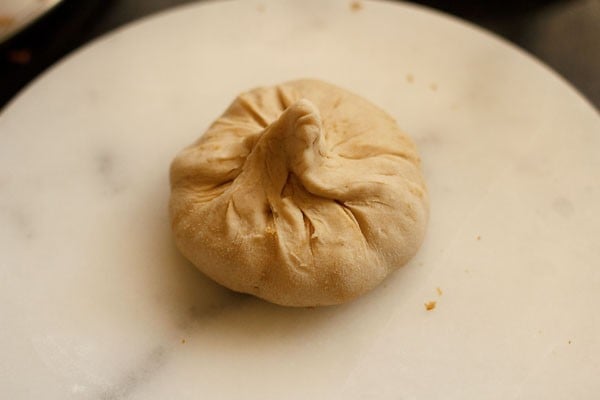
13. Sprinkle some flour and start rolling the dough.
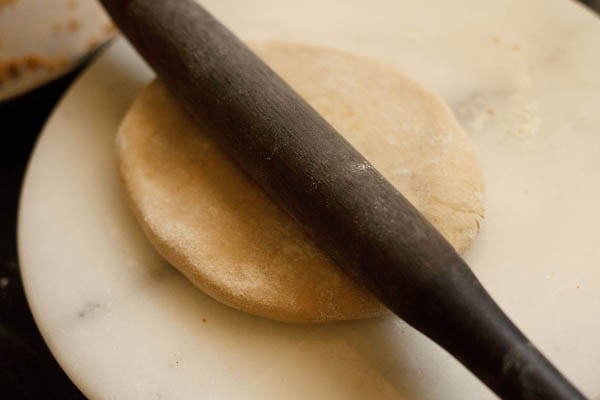
14. Make a medium or large circle (poli) as depending upon the size of the dough and puran filling you took. The cover should be rolled rather thin, so you can almost see the filling beneath it.
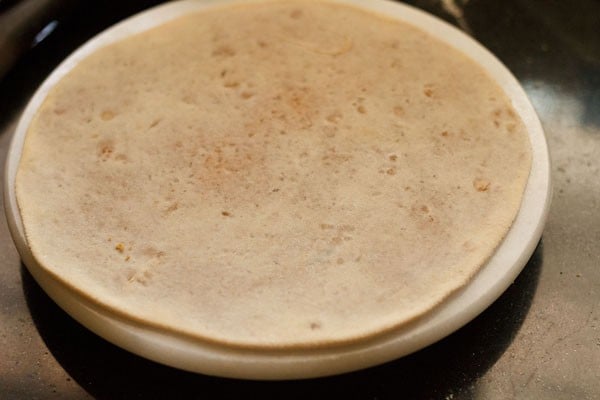
Roast Puran Poli
15. On a heated tawa or griddle, spread some ghee.
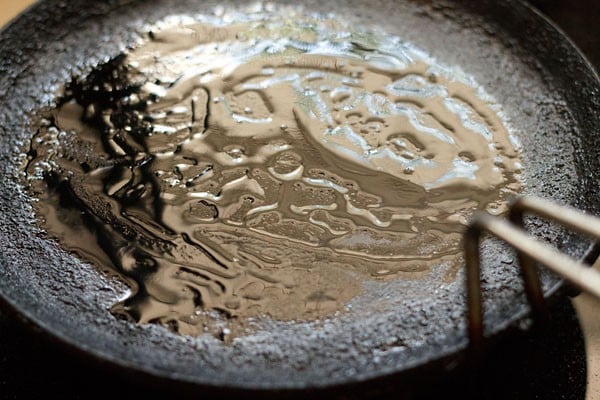
16. Place the rolled poli/dough circle on the tawa.
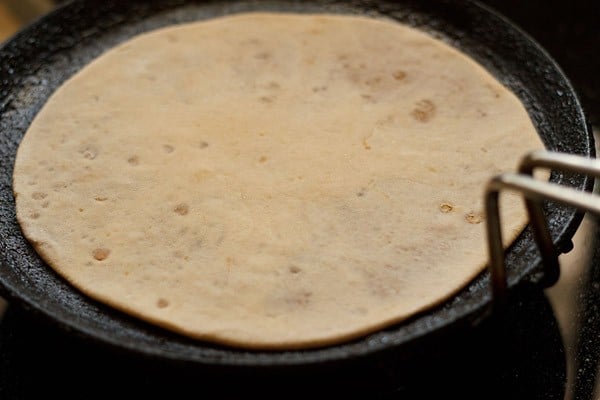
17. When one side gets browned, turn over and cook the other side till you see some brown spots.
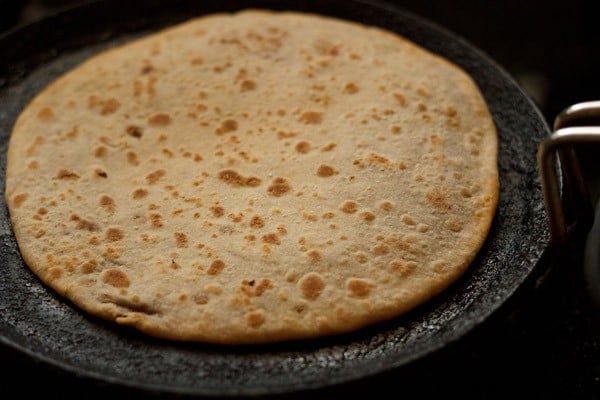
18. Once the second side is brown, turn over and apply ghee. If everything is done properly then puran poli will puff up.
Make all pooran poli this way and stack them in a casserole or in a kitchen napkin.
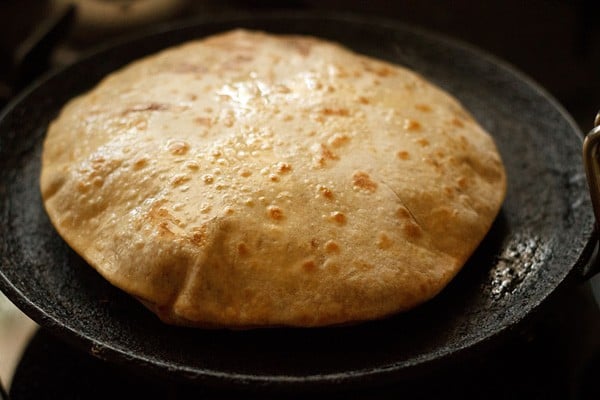
19. You can serve puran poli warm or at room temperature with milk, ghee or curd (yogurt). Enjoy!
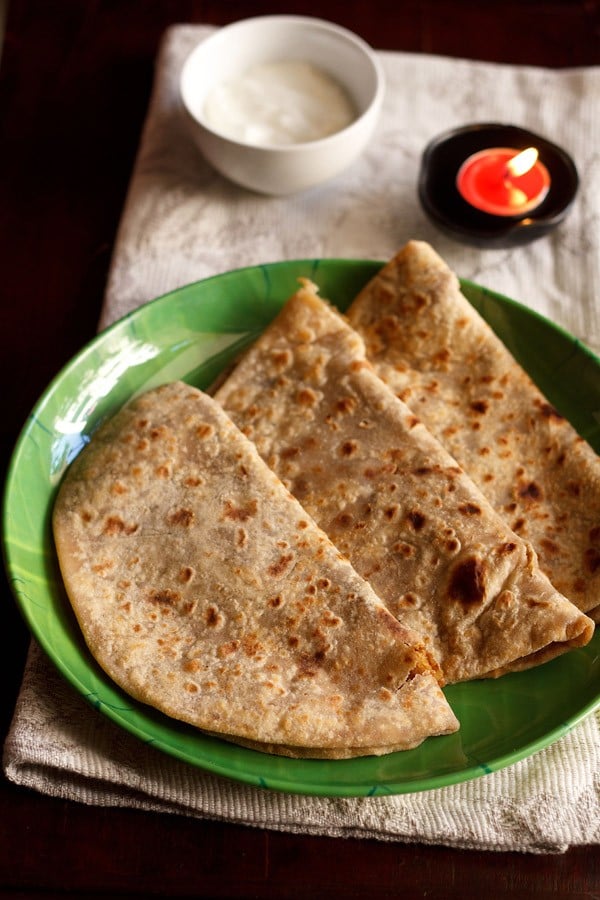
Expert Tips
- You can cook the lentils in a pot or pan, stovetop pressure cooker or an Instant Pot. If cooking lentils in a pot on the stovetop, then ensure to soak them for an hour or two.
- Use the leftover stock for making katachi amti (Maharashtrian style thin spiced dal) or you can even use it in your other vegetable dishes and roti dough or to make soups.
- Make sure to mash the puran mixture very well. If not done so, the whole pieces of lentils may cause the dough to crack or tear while rolling. To mash, you can use a potato masher, strainer or the typical equipment ‘puran yantra,’ which is similar to a food mill in America.
- Instead of whole wheat flour (atta), you can also make the dough with all-purpose flour (maida) or half-half of both the flours. Or opt to use whole wheat flour entirely.
- While rolling the Puran Poli, be careful. If it breaks or tears a little, then no issues. Just add some dry flour to that part and gently roll. When making for the first time, it may break. But that should not stop you from making. With practice, one gets better.
- The color of the Puran Poli will vary with the color of the jaggery used.
- You can make these Maharashtrian sweet flatbreads ahead of time and refrigerate to keep well for up to a week. You can also freeze them by separating cooked ones with sheets of parchment paper. Then, place these in an air-tight container and freeze for up to a month. Reheat by placing them on warm ghee on a tawa or griddle.
- Make vegan Puran Poli recipe by swapping ghee with a neutral tasting oil like vegetable oil, grapeseed oil or sunflower oil.
FAQs
Absolutely! They will last for up to a week in the refrigerator.
Yes! Cooked puran poli can be separated with sheets of parchment paper, placed in an airtight container and frozen for up to 1 month. To reheat, simply warm some ghee on the tawa and griddle them until warmed through.
Sure! Simply swap in a neutral flavored oil for the ghee. I recommend vegetable oil or grapeseed oil or sunflower oil.
I’d say the proportions should be roughly 1:1 for the amount of dough and filling used.
More Festive Sweets To Try!
Ladoo Recipes
Ladoo Recipes
Sweets Recipes
Please be sure to rate the recipe in the recipe card or leave a comment below if you have made it. For more vegetarian inspirations, Sign Up for my emails or follow me on Instagram, Youtube, Facebook, Pinterest or Twitter.
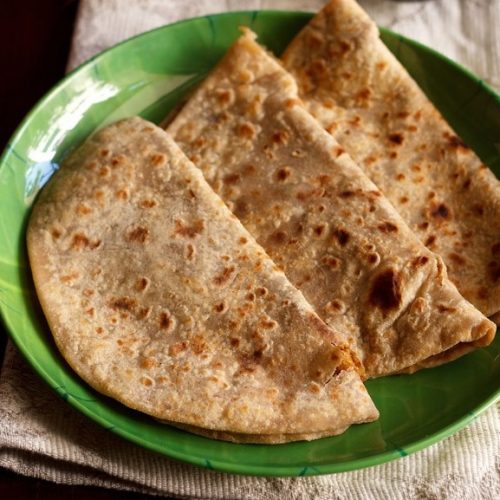
Puran Poli Recipe
Ingredients
For puran mixture – sweet filling
- 1 cup chana dal (skinned split bengal gram)
- 3 cups water – for pressure cooking the chana dal
- 2 teaspoons Ghee
- 1 teaspoon fennel powder (ground fennel)
- ¾ to 1 teaspoon dry ginger powder (ground ginger)
- ½ teaspoon green cardamom powder (ground cardamom)or seeds from 4 to 5 green cardamoms crushed finely in mortar
- ¼ teaspoon nutmeg powder (ground nutmeg)
- 1 cup jaggery powder or 1 cup grated jaggery
for the poli – outer covering
- 1.5 cups whole wheat flour
- ½ cup all-purpose flour
- 4 tablespoons oil or ghee (clarified butter)
- ½ teaspoon salt or as required
- ¼ teaspoon turmeric powder (optional – to give a faint yellow color to the poli)
- water as required to knead the dough
- oil or ghee, as required for roasting the puran poli
Instructions
Preparing Puran (sweet lentil filling)
- Rinse the chana dal first very well in water. I didn’t soaked the chana dal but you can also soak the chana dal for 30 minutes to one hour and then drain the water.
- In a 3 litre stovetop pressure cooker, cook the chana dal with 3 cups water for 6 to 7 whistles on medium heat.
- The dal has to be cooked well. If you soak the chana dal, the cooking time will be reduced. Once the pressure settles down on its own in the cooker, then only open the lid. Carefully strain the cooked dal using a sieve. Drain all the water or stock from dal.
- Keep the stock aside. This stock can be used for making Katachi Amti which is a thin tempered dal or you can just add it to your everyday cooking of roti, rice or vegetables.
- Heat ghee in a frying pan or kadai (wok) and add the ground ginger powder, ground nutmeg powder, ground cardamom powder and ground fennel powder.
- Fry these ground spices for a few seconds on a low heat.
- Add the chana dal and jaggery. Stir and let this puran mixture cook on a low heat till the mixture becomes dry.
- Keep on stirring the puran mixture at intervals.
- Once the puran stuffing become dry and thick, switch off the heat.
- Let it cool and then mash the puran mixture with a potato masher. You can also use your mixer to mash the puran mixture very well. Set aside.You could also use puran yantra if you have it.
Preparing the poli dough
- Meanwhile take whole wheat flour, all purpose flour and salt in a bowl mix well.
- Add a little bit of water and ghee and mix. Begin to knead the dough adding water as needed.
- The dough should be smooth, supple and soft. Cover and keep aside the dough to rest for 15 to 20 minutes.
Making puran poli
- Take a medium or large size ball from the dough. Roll it 2 to 3 inches in circumference on a dusted rolling board.
- Place a portion of puran mixture in the center of the rolled dough.
- Bring the edges together towards the center. Join all the edges and pinch them.
- Sprinkle some flour and start rolling the dough.
- Make a medium or large circle (poli) as depending upon the size of the dough and puran filling you took.
- On a heated tawa or griddle, spread some ghee. Place the rolled poli/dough circle on the tawa.
- When one side gets browned, turn over and cook the other side till you see some brown spots.
- Once the second side gets browned, then turn over and apply ghee. If everything is done properly then puran poli will puff up. The poli should be cooked well with brown spots and golden.
- Make all puran polis this way and stack them in a casserole or roti basket or in a kitchen napkin.
- You can serve Puran Poli warm or at room temperature with milk, ghee or curd (yogurt).
Notes
- While rolling the puran poli, be careful. If it breaks a little, then no issues. Just add some dry flour to that part and continue to roll. When making for the first time, the pooran poli may break. But that should not stop you from making puran poli. With practice, one gets better.
- Instead of whole wheat flour, you can also make the dough with all purpose flour or half-half of both the flours. Or opt to use whole wheat flour entirely.
- Remember to knead the dough really well. It should be soft, supple and pliable. Add water as needed to get a soft dough.
- The color of the puran poli will vary with the color of jaggery used.
- The recipe is scaleable and you can easily make a small batch or a large batch.
Nutrition Info (Approximate Values)
This Puran Poli recipe from the archives first published on September 2012 has been republished and updated on March 2023.
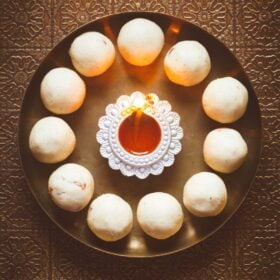
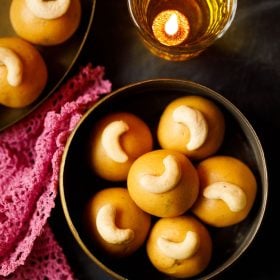
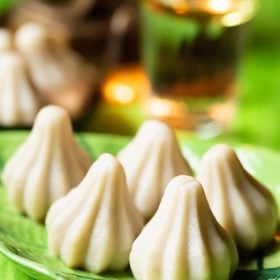
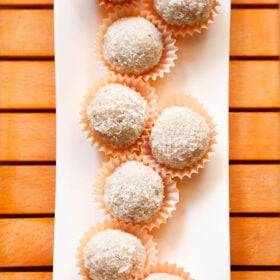
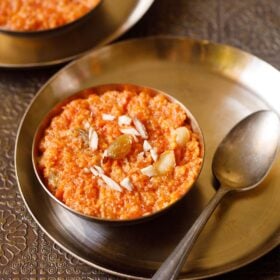
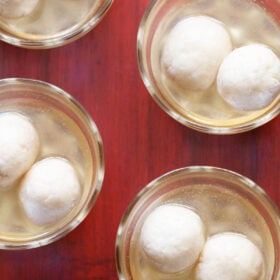
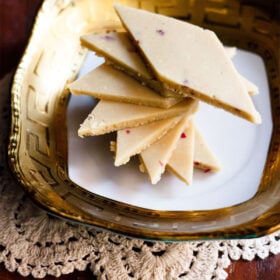








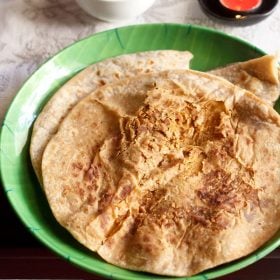
Hello mam, I jst wantd to ask u dat can we add some dry fruits(cashew nuts,almonds, pistachios) in d filling to make it more delicious…
anjali, you can add but you have to chop them very finely. otherwise dry fruits can come out of puran poli.
hi dassana , excellent recipe and taste …
rgds
thanks marina for positive views 🙂
Hi dassana, I had made puran look for the first time and it came out very nice.. did not make any mistakes… also tried your masala bhaat and amti dal… everyone liked it… thanks for sharing…
Regards n tk care
Marina
welcome always marina, thanks for positive views.
I made it for the first time and it came out superb.
thanks jaya for positive feedback 🙂
Hello mam ,
My whole family loved your recipes and all comes out awesome .
Thanks a lot
welcome kabita. glad to know this.
hi Dassana, this recipe worked out perfect! the puran polis turned out awesome, many thanks to you!
welcome ramya. glad to know this.
Hi,I have time and again tried and made many of your recipes… And every time it has come out awesome.. Thank you so so much
welcome roopa and thanks for positive feedback 🙂
Awesome website and recipes. Keep recommending you to my friends. Keep up the good work
thankyou so much padmini now we know where we are getting the traffic from 😉
I followed d recipe but my filling remained more like a powder than becoming a solid lump… What did I probably do wrong??
was the dal cooked well. the dal should be cooked till soft. powdery consistency can also be due to the quality of jaggery. just melt some jaggery and add and the mixture will be moist.
Yes d dal was cooked well… Cud be coz of jaggery
could be due to the jaggery. for puran poli its always good to use the brown colored jaggery.
This is exactly the procedure which we follow, though we soak the dough in oil. Also, while preparing the dough, my mom first mixes haldi with a little milk of lime and then adds atta(we use only atta and no maida), thoroughly mixes it and then kneads into a dough. Soaks the dough in oil for about 3 to 4 hours before preparing the polis. However, while frying the polis on tawa, we don’t use any any oil.
thanks sirisha for sharing with me the method of preparing puran poli by your mom. what is little milk of lime? or did you mean little milk or lime? since the dough is soaked in oil, i don’t think there is any need to fry the poli without adding any oil. makes sense the way your mom prepares the puran polis. just curious in how much oil do you soak the dough.
Milk of lime – the clear water of choona(the one we use for paan). Usually she spreads the dough in a flat bowl and completely covers it with oil. After 3 to 4 hours, she drains the complete oil out and then uses the dough to prepare the polis. She would drain out the exact amount of oil she used to soak :). So, it’s like though you soak it in oil, you still don’t use much oil at all.
fine. i thought so that it would be milk of lime, but just wanted to be doubly sure, hence asked you. the oil soaking part is done so well by your mother. kudos to her 🙂
In Trinidad we call this Dhal puri… Its made with alot more spices including ground geera and hot chill peppers as well as some chive and thyme, we leave out the jaggery and make it into a more savory dish.
thanks ashvini for sharing the trinidad version and name of the recipe. sounds delish.
Woww..Wowww…wowww…First of all let me tell you what a Greatttttt cook you are…!!!!Love all ur recipes..So simple to follow with beautiful step by step illustrations….
thankyou so much anshu 🙂
Hi Dassana,
Thanks for the yummy recipe. I tried it and found out that the puran is not sweet enough for our taste. What should i do to make it sweeeter after it is cooked? should i just add more jaggery to it and heat for some time? please advise.
Yes add some more jaggery and cook it for few minutes.
nice explaination i vill try soon
hi Dassana
this is so good. we make this in Andhra but its complete maida and uses so much ghee, this is perfect. thanks for the recipe..:) love ur pictures and details…
welcome manasa. thanks for your positive feedback.